As your boat winds through the clear blue waters between green islands scattered with tiny homes, the sun starts to set. The ferry driver slows down to navigate a thin island passageway, then backs into a dock nearby. As you disembark, someone points toward the water, where you see a pod of orcas.
“The San Juan Islands are unlike any other destination I’ve been to,” says Heather Gyselman, REI Adventures program manager for North America. “Each of the islands are different from one another, and they offer the perfect combination of really spectacular scenery, quirky village scenes, outdoor activities [like kayaking, hiking and biking], wildlife and culture. I consider Seattle the brain of Washington and the San Juan Islands, the heart.”
If you’re considering an adventure in the San Juan Islands, this guide is for you. It will cover:
- Why Visit the San Juan Islands?
- The Top Destinations in the San Juan Islands
- The Top Outdoor Activities in the San Juan Islands
- How to Plan Your Trip
Why Visit the San Juan Islands?
There are 172 named islands and reefs in the San Juan Islands, most of which can only be accessed by private boat or kayak. The San Juans are close to the U.S.-Canada border, located an approximately three hour combined drive and ferry ride from Seattle. The islands feature miles of shoreline, lakes, forests, mountains and national parks. But most people know the San Juan Islands for their three resident pods of orcas and other marine mammal populations, such as sea lions, river otters and porpoises.
The San Juans are a popular travel destination because they offer a temperate climate year-round. During the summer, temperatures on the islands can reach 70 degrees Fahrenheit; during the winter, they rarely drop below 40. These maritime temperatures make the islands a perfect place for outdoor adventures year-round, whether you like to hike, bike, kayak, swim or go whale watching.
“Take it easy and just relax once you’re there. Things run on ‘island time.’ Where most of us are used to rushing at a fast pace, the islands are more laid back and easy going,” says Gyselman.
The Top Destinations in the San Juan Islands
The region’s four largest islands can be reached by ferry. These include:
San Juan Island is the second largest island in the archipelago, according to the San Juan Island Chamber of Commerce. It is the most populous of the San Juan Islands and is known for its many whale watching tours, vineyards, hiking spots and restaurants. While visiting San Juan Island, plan to wander the driftwood-strewn shores and visit the local historical sites, like the many lighthouses and small towns. Friday Harbor is the island’s beating heart, and it offers lots of galleries, restaurants, hotels and museums for travelers. Many visitors come to Friday Harbor by boat and stay overnight in the large marina. Roche Harbor is also a popular stop on San Juan Island
“On San Juan Island, I love the combination of scenery and history offered during a visit to American Camp followed by a walk down to South Beach,” says Gyselman.
This 57-square-mile, horseshoe-shaped island, the largest in the archipelago, is full of forests, lakes and beaches, making it one of the best choices for outdoor lovers. You’ll find the island’s largest town, Eastsound, at the center of the horseshoe. Eastsound is a charming town with restaurants, shops and whale watching tours. You should also plan to visit Deer Harbor, West Sound and Orcas Village (where the ferry lands).
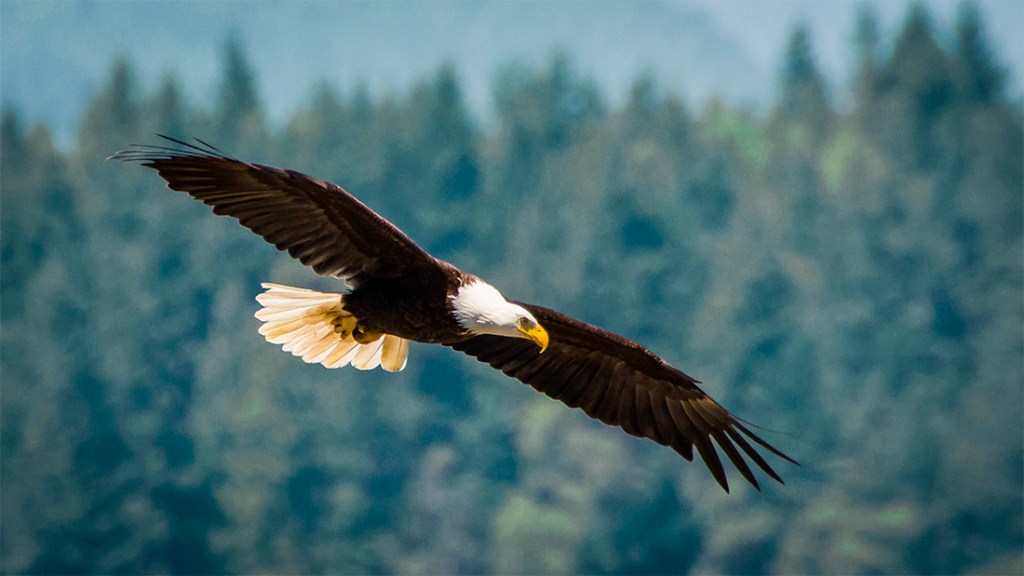
Orcas Island is a popular destination with cyclists, who relish the challenging, hilly terrain, as well as with hikers and campers. Orcas Island also contains Moran State Park, the fourth largest state park in Washington, which offers more than 38 miles of hiking trails and more than 124 campsites. You can also hike (or drive) up Mount Constitution, which takes you to a lookout tower on the island’s highest point. From the top, you can see Mount Baker and Canada.
“Orcas is a really great destination for families,” says Gyselman. “My favorite spots are Rosario Resort with its marina, indoor saltwater pool (they have an outdoor pool in the summer), various lawn games and small restaurants. Eastsound is a fun little village, and Moran State Park has camping, hiking and a couple of lakes where you can canoe, SUP, kayak and more.”
Lopez Island is known as “the friendly isle.” It’s only 15 miles long and is the flattest island topographically in the larger San Juans, making it a good choice for cycling. Generally, Lopez is a much quieter choice than Orcas and San Juan, which can be bustling during the summer months. On Lopez Island, visit Lopez Village for its cafes and shops. Otherwise, enjoy being left to your own devices in relative isolation. Spencer Spit State Park offers quality hiking and camping in a setting where it’s easy to feel like you’re off the grid.
Shaw Island is accessible by ferry but doesn’t have restaurants, markets or hotels—or cars, for that matter. Most visitors choose to visit Shaw Island as a day trip by walking their bikes onto the (free!) ferry from Orcas Island. The island’s resident nuns don’t welcome the ferry into the terminal anymore, but they still run an active farm and encourage visitors. Shaw County Park offers wonderful shoreline views and 10 sheltered campsites in the woods above the beach for adventurous travelers. During the summer, making reservations for these sites is recommended. During the winter months, they’re first come, first served.
You can travel to the other 168 smaller islands and reefs via private vessel.
The Top Outdoor Activities in the San Juan Islands
1. Hiking
The San Juan Islands offer many opportunities for hiking adventures, including rocky bluffs, mountains, lakes, beaches, vistas and more. Some of the most popular hikes on the islands include:
This mountain on Orcas Island is 2,409 feet high, offering incredible views of the San Juan Islands. From the top, you can see Vancouver, Canada; Mount Baker and Mount Rainier. There’s a paved road all the way up Mount Constitution or you can choose from a variety of groomed trails around the mountain in Moran State Park.
The full hiking loop to the top of Mount Constitution is 6.7 miles round-trip with 1,500 feet of elevation gain. Once at the top, be sure to take advantage of the recently restored stone lookout tower built by the Civilian Conservation Corps in the 1930s.
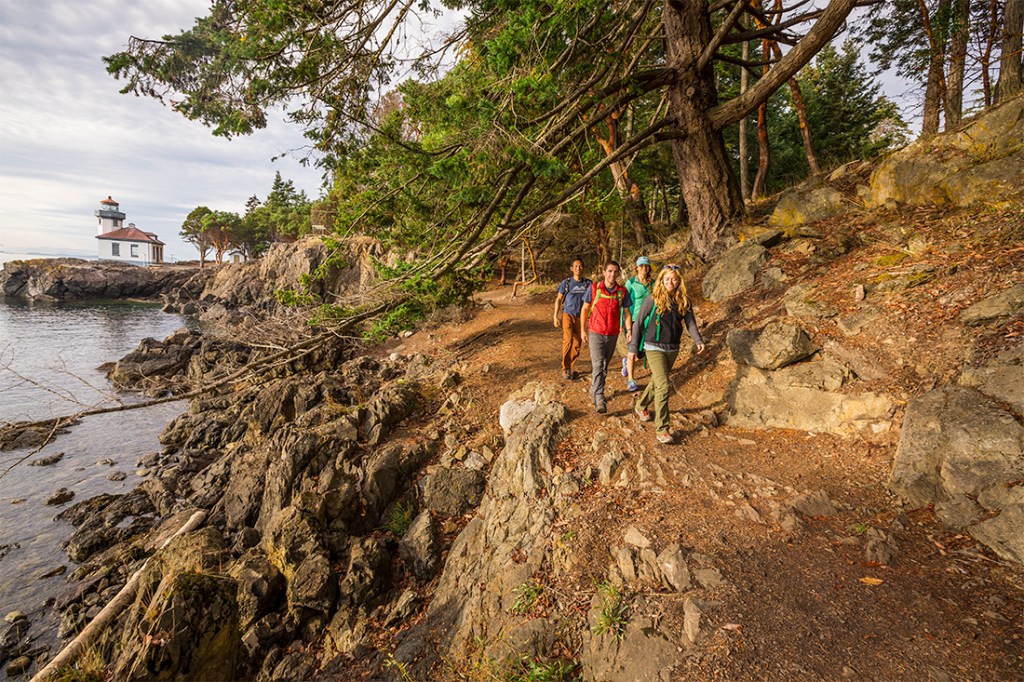
This 1,520-foot Orcas Island mountain is the second highest point in the islands and offers gorgeous views from along a relatively undeveloped ridgeline. The Turtleback Mountain Preserve is also home to a number of animals and plants. The main loop here is 3 miles round-trip with less than 1,000 feet of elevation gain, making it an accessible spot for hikers of any skill level.
This 2-mile round-trip hike offers dense forests and beautiful ocean views. There are also nine backcountry campsites available within the park.
This popular lake loop in Moran State Park is 3.9 miles long and offers quiet spots tucked into the foggy forest, as well as lovely lake views. On summer days, you can also rent a SUP or kayak to explore the lake’s watery inlets, or you can take a quick dip in the lake to cool off after your hike.
Iceberg Point
This hike is located on the southwest tip of Lopez Island, where the sheer bluffs give you a great spot for watching sea life and stretching your legs. The hike isn’t too long or strenuous (just 3 miles round-trip with 50 feet of elevation gain), but the views are known to be some of the best on the island, especially for spotting orcas.
2. Cycling
Cycling enthusiasts head to the San Juan Islands in droves each year because of the varied terrain, easy day trips and temperate climates. Each of the islands has something different to offer cyclists of all ability levels:
Lopez Island
Lopez Island is the least hilly of the San Juans, and you can cycle the whole island in a day. From the ferry, bike 4.3 miles to Lopez Village (maybe stop at the Whispers of Nature Herbal Labyrinth) with a possible side trip to Spencer Spit State Park. Then head to the Shark Reef Sanctuary on the west side of the island for a close-up look at seals before visiting the Agate Beach County Park.
San Juan Island
Cycling on San Juan Island is more challenging, and while you can circumvent the island in a day, it’s a 35-mile loop that definitely offers a physical workout. The island also features a lot of hills and roads with narrow shoulders, so use an abundance of caution. One of the most popular island routes leaves from Friday Harbor on Roche Harbor Road, then takes you through the San Juan Vineyards and the Roche Harbor Resort to the San Juan Islands Sculpture Park.
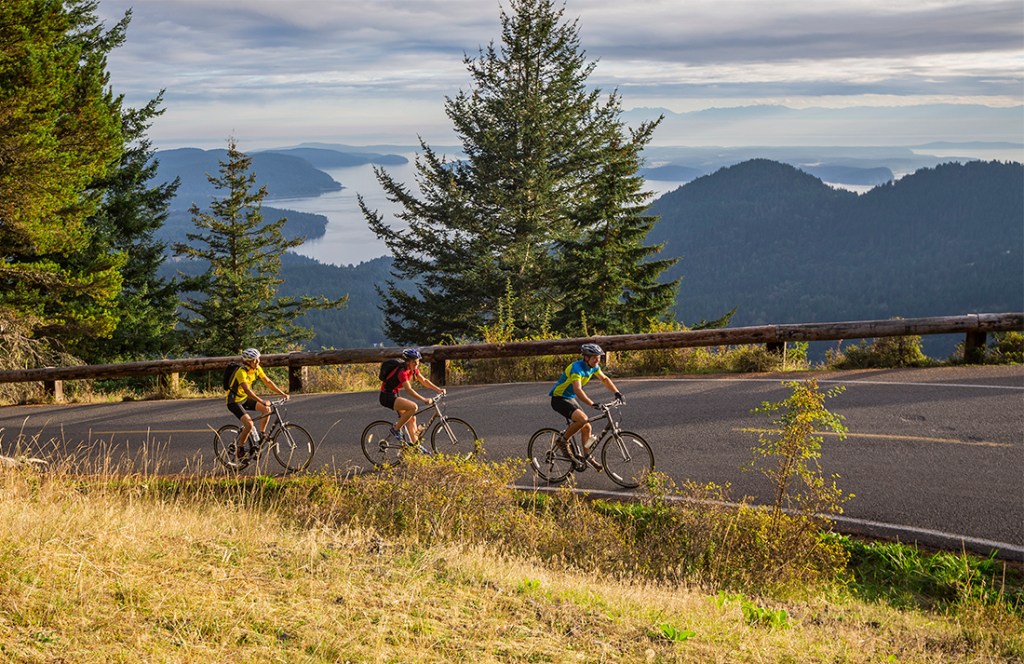
Next, stop at the Krystal Acre Alpaca Farm and Country Store before checking out Lime Kiln Point State Park (a renowned spot for whale watching) before passing by the Pelindaba Lavender Farm. The route continues on to South Beach, which offers stellar views, before looping back into Friday Harbor.
Orcas Island
Orcas Island is perhaps the toughest island for cycling in the San Juans. The grades are steep, and the roads are narrow and winding. The route up to the top of Mount Constitution is exhausting, but the views are incredible. A common route will take you from the ferry landing to Eastsound to the farmlands at the base of Turtleback Mountain before winding through Moran State Park. (We recommend stopping for a swim at Cascade Lake.) This loop includes a climb up 2,409-foot Mount Constitution before winding through Buck Bay Shellfish Farm (shuck some oysters here!). Finally, you’ll pass through the Obstruction Pass and Doe Bay areas before heading back to the ferry landing. Doe Bay Cafe is an excellent place to stop for lunch, but check first as sometimes it’s only open for dinner.
3. Kayaking
“You can’t go to the San Juans without spending time on the water. Kayaking is a terrific option,” says Gyselman. “Getting out into some of the quiet coves and onto the smaller islands gives you an intimate look at the abundance of marine life. It’s also the perfect way to pause and reflect on the destination.” While you can bring your own kayaks or rent them on the islands, some of the best excursions involve renting kayaks from a certified outfitter who will also provide a guided tour to show you the best places to spot wildlife. Make sure to follow these safety and conservation instructions if you head out alone.
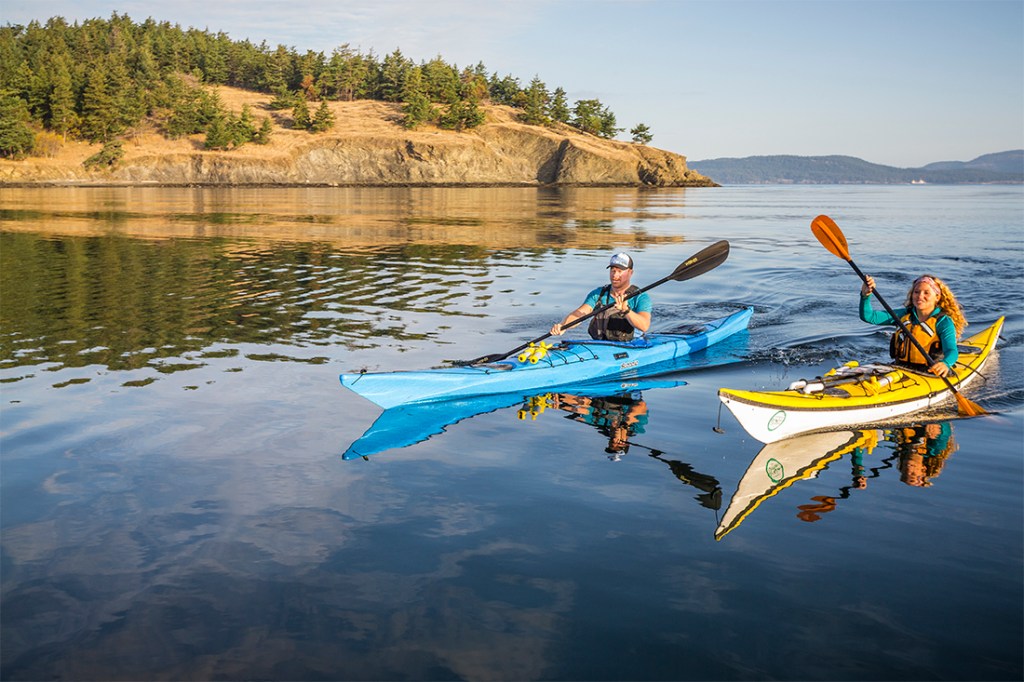
Some of the best kayaking spots on the islands include:
Lopez Island
From Lopez, you can visit a bunch of small, protected national wildlife refuge islands that have been set aside for animals. Some of the best are Fortress Island, Skull Island and Crab Island. It’s also worth paddling over to where the Rosario Strait meets the Strait of Juan de Fuca, at the southwest part of the island.
Orcas Island
Orcas is a great spot for beginner kayakers, who can explore miles of shoreline in all kinds of conditions. From the north shore, explore the marine state park islands (Sucia, Matia and Patos are a good start). You can also pack your kayak into your car and paddle Cascade Lake and Mountain Lake in Moran State Park.
San Juan Island
Put in at San Juan County Park (where you can also camp) or explore Roche Harbor Resort by the water. Whales often pass through the Haro Strait or Boundary Pass, which are worth checking out on guided kayaking tours. You’ll also get views of the Olympic Mountains and Vancouver Island from San Juan Island.
4. Whale Watching
The San Juan Islands are perhaps best known for their three resident orca pods, which frequent the waters from late spring through early fall.
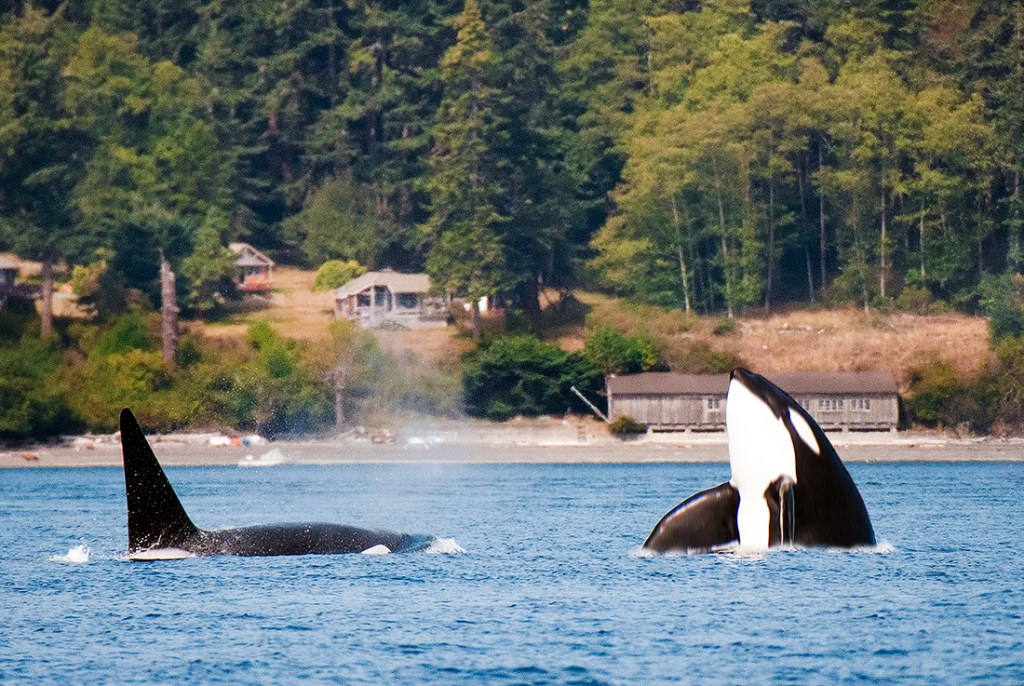
The pods—known as J, K and L—are endangered and federal law dictates that all vessels must keep at least 200 yards from any whale. You can also spot humpbacks and minke whales in the San Juans. Most whale watching tour operators will honor your ticket at a later date if you don’t see any whales during your tour.
How to Plan Your Trip
The Best Time to Visit
You can visit the San Juan Islands year-round. The islands have an average of 247 days of sunshine per year and only half as much rain as Seattle.
In the summer months of late June through early September, temperatures on the San Juan Islands hover around the high 60s and low 70s, and the islands bustle with activity. During the summer, the ferries operate on their full schedules (you’ll definitely want to make reservations or risk spending hours in line!), and you’ll have more opportunities to get outside, given the temperate climate.
During the winter, the temperatures on the islands range from 40 to 50 degrees. While the ferry schedule is more limited, the islands are also quieter during the winter. Parts of Moran State Park allow for winter camping as well.
During the shoulder seasons of fall and spring, expect moderate temperatures and relatively slower crowds.
“Summertime will have the best weather but with [the islands’] temperate climate, you can really visit any time of year and have a wonderful experience,” says Gyselman. “You’ll also contend with crowds during the summer. Visiting during the winter is always compelling to me as well. The landscape is gorgeous but looks different. Visiting during the off-season gives you a feel of what it’s like to be a local.”
What to Pack
The islands can get chilly, even during the summer months.
“Plan for any kind of weather. It can be rainy, windy, hot, cold or anywhere in between all year long,” Gyselman says. “Layers are your friend in the San Juans and will ensure that you’re ready for anything.”
She recommends bringing base layers, a fleece mid-layer, a down jacket and rain layers. If you visit during the summer months, pack a swimsuit. If you plan to kayak with a tour group, you’ll probably be given a drysuit or at least extra layers. The Pacific Ocean stays cold year-round.
Getting To and From the Islands
You can reach the San Juan Islands via the Washington State Ferries in Anacortes, a private float plane or by taking the passenger-only San Juan Clipper from Seattle to Friday Harbor, San Juan Island.
To take the ferry, drive (or take a shuttle from the Seattle-Tacoma International Airport) to the Anacortes Ferry Terminal. If you choose to walk on to the approximately 1.5-hour ferry (which is a cheaper option than driving onto the boat, and also doesn’t require reservations), you can pay for overnight parking in one of the extended lots. If you choose to drive onto the ferry, you’ll want to make your reservation months in advance; during the summer, weekend ferry spots book up completely. The ferry ride is beautiful and winds through the archipelago, offering stops at four islands: Lopez, Orcas, Shaw and San Juan.
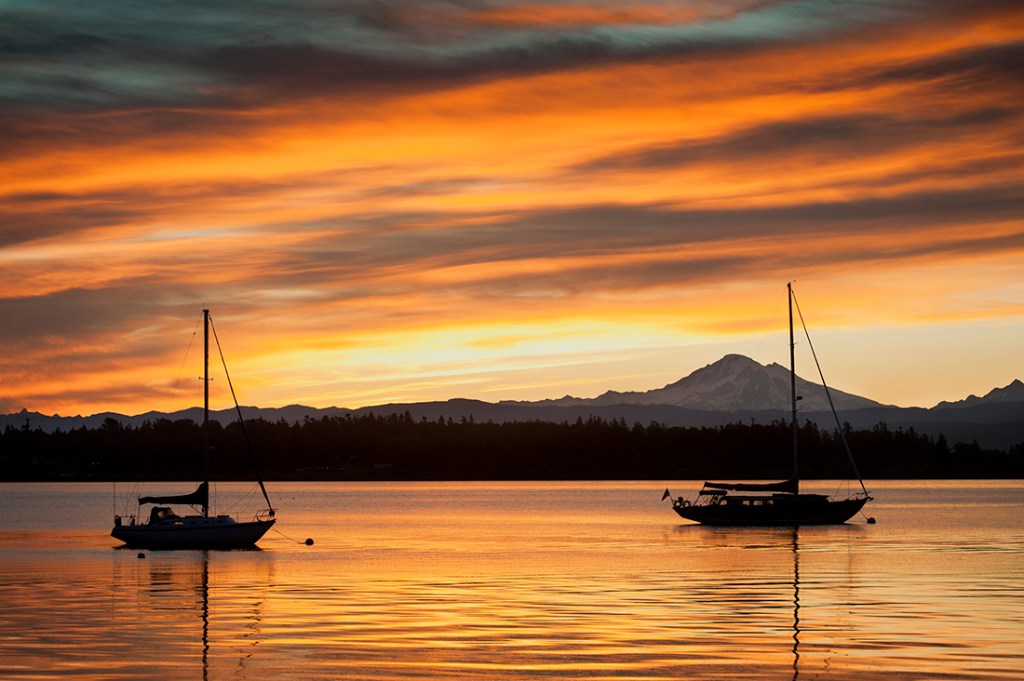
“Book your round-trip ferry reservations early, especially if you plan on driving onto one of the Washington State ferries,” says Gyselman. “Space books up fast, and you don’t want to be disappointed by not getting space on the way over or stuck trying to get home. Camping and lodging also books up fast, so book early!”
If you choose to take the San Juan Clipper from downtown Seattle, plan for a 3.5-hour boat ride to Friday Harbor.
Float planes are usually chartered independently from local companies like Kenmore Air, Friday Harbor Seaplanes, Point-to-Point Air and San Juan Airlines. Some of these companies offer daily scheduled flights. Prices vary depending on the company and season.
Where to Stay
Any of the major islands listed above will have options for staying in hotels, homestays and campsites.
- On Orcas Island, camping in Moran State Park is always a good bet. There are plenty of site options, although you’ll likely want to book them in advance if you can. Eastsound is the island’s biggest town and contains multiple hotels and rental houses, which you can find on VRBO or Airbnb.
- Shaw Island doesn’t have any hotels and only offers a few backcountry camping options.
- Lopez Island is small and has fewer options for overnight stays than Orcas or San Juan, although you can find some Airbnbs or VRBOs if you look far enough in advance.
- San Juan Island is the busiest island, and you can find luxury or basic accommodations all over the island, especially in Roche Harbor or Friday Harbor.
